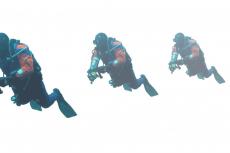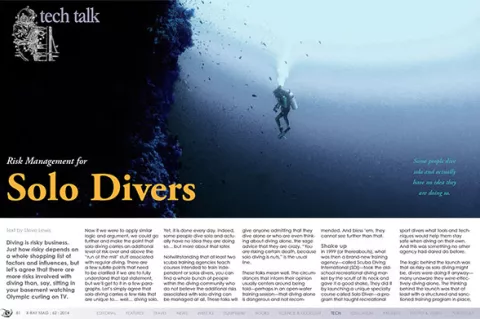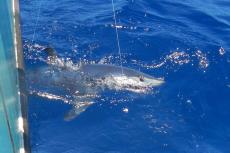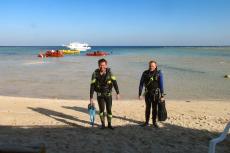Diving is risky business. Just how risky depends on a whole shopping list of factors and influences, but let’s agree that there are more risks involved with diving than, say, sitting in your basement watching Olympic curling on TV.
Contributed by
Now if we were to apply similar logic and argument, we could go further and make the point that Solo Diving carries an additional level of risk over and above the “run of the mill” stuff associated with regular diving.
There are a few subtle points that need to be clarified if we are to fully understand that last statement, but we’ll get to in a few paragraphs: let’s simply agree that solo diving carries a few risks that are unique to… well… diving solo. Yet it is done every day. Indeed, some people dive solo and actually have no idea they are doing so… but more about that later.
Notwithstanding that at least two scuba training agencies teach courses intended to train independent or solos divers, you can find a whole bunch of people within the diving community who do not believe the additional risks associated with solo diving can be managed at all.
These folks will give anyone admitting that they dive alone or who are even thinking about diving alone, the sage advice that they are crazy. “You are risking certain death, because solo diving is nuts,” is the usual line.
These folks mean well. The circumstances that inform their opinion usually centers around being told – perhaps in an open-water training session – that diving alone is dangerous and not recommended. And bless ‘em, they cannot see further than that.
Shake up
In 1999 (or thereabouts), what was then a brand-new training agency – called Scuba Diving International (SDI) – took the old-school recreational diving market by the scruff of its neck and gave it a good shake. They did it by launching a unique specialty course called Solo Diver: a program that taught recreational sport divers what tools and techniques would help them stay safe when diving on their own. And this was something no other agency had dared do before.
The logic behind the launch was that as risky as solo diving might be, divers were doing it anyway – many unaware they were effectively diving alone. The thinking behind the launch was that at least with a structured and sanctioned training program in place, people could at approach solo diving with the right mindset and correct equipment to do it with the proper controls in place.
When the folks at a training agency come up with a brand new idea like: “Hey, let’s teach people to dive solo,” taking that concept from a doodle on the back of a paper napkin to a full-blown program with instructor guides, student materials, and standards underwritten by a reputable insurance company, involves a great number of steps that follow a pretty well-defined pathway. Anyone who’s been involved in the task will tell you it’s not an easy process. The first step is to define what it is you intend to teach and to whom.
Solo diving was defined as self-sufficient diving. To define the program’s target market, was not as straightforward. The circumstances where someone might find themselves diving solo had to be a little broader than simply diving without a buddy and being in the water with nobody else around.
Definitions
For instance, solo could also be defined as someone diving with a buddy who is way less experienced and upon whom they would rather not rely in the case of an emergency. After all, logic dictates that if you are diving with someone whose help can’t be guaranteed if the Rottweilers hit the fan, you’re effectively diving solos. By the same token, solo might also be someone who dives with other folks in the water, but who is doing “their own things,” which is a diplomatic way to describe the buddy skills of most underwater photographers!
Insta-buddy experience
It may also describe a travelling diver who finds themselves on a dive boat coupled with an “Insta-buddy” whose experience, abilities and dive habits are a total mystery. And solo diver fully describes every instructor who takes students into the water in a class setting. In an emergency, that instructor MUST be capable of “self-rescue,” because it would be unfair and perhaps unrealistic to rely on a student to help. Having defined what solo diving is, the next steps are to understand and define just how risky each of those situations is, and if those risks are manageable.
In reviewing its solo diver program, SDI’s training advisory panel looking really closely at the previously common blanket statement: “You are risking certain death, because solo diving is nuts…” to see if it is indeed true or simply blinkered thinking. In the world of diving, risk management always begins with a risk identification stage: what risks does the activity – in this case solo diving – carry with it and what is their potential outcome?
The next stage is to assess each of the identified risks on a scale that stretches from Very Likely to Extremely Unlikely. And the third stage is to come up with a tactical plan that avoids or mitigates ALL the very likely and likely risks, as well as dealing comfortably with the risks that have only a small chance of happening. (...)




























